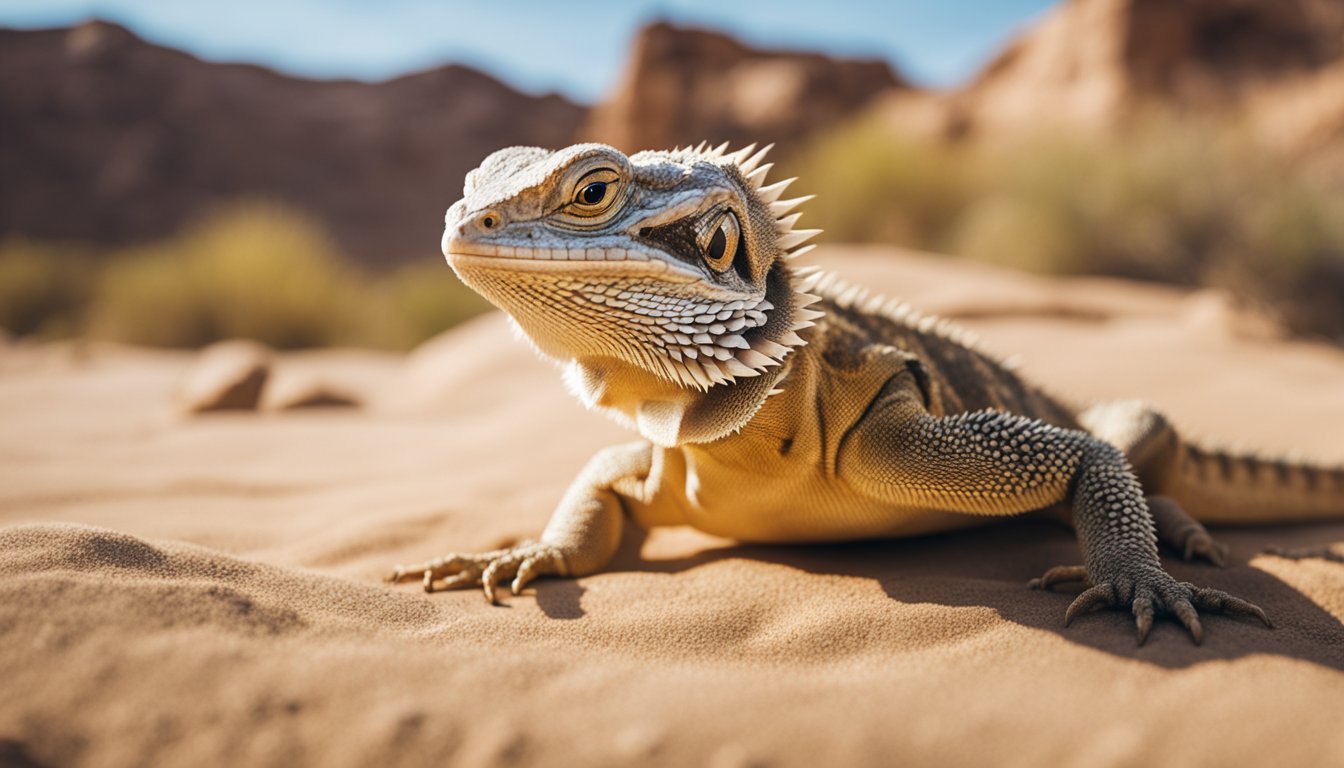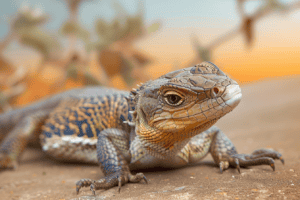Bearded dragons are fascinating creatures that call the harsh environments of the Australian deserts home.
They have adapted to survive in a place where temperatures can soar during the day and plummet at night.
Imagine walking on hot sand under the blazing sun one moment, and then feeling the cool, chilly breeze of the desert evening the next.
That’s the daily life of a bearded dragon, who must be smart and sturdy to live in such extremes.

These reptiles are named “bearded” because of the spiky scales under their throat, which puff up when they feel threatened, almost like an umbrella opening up.
This makes them look bigger to scare away predators.
These spikes are not just for show; they help the bearded dragon survive the challenges of desert living.
What’s also interesting is how they communicate. Have you ever seen a lizard wave?
Bearded dragons actually wave at each other as a way to say hello or to show that they come in peace.
One of the coolest things about bearded dragons is the way they eat. They are omnivores, which means they munch on both plants and insects.
When they spot a tasty meal, they use their long, sticky tongues to catch it, just like a superhero with a lasso.
In the wild, they watch and wait until an unsuspecting insect comes by before they shoot out their tongue to grab it.
They also like to bask in the sun to warm up since they are cold-blooded, but when the desert gets too hot, they burrow underground to stay cool.
Life in the desert is a balancing act, and the bearded dragon is an expert at it.
Desert Environments
Bearded dragons live in the arid and sun-soaked landscapes of the Australian desert.
In these vast expanses of sand and rock, the heat can be relentless, and water is a precious treasure.
Adaptations to Heat
The sun blazes down with intense heat in the desert, and bearded dragons have evolved unique traits to survive.
They are cold-blooded, or ectothermic, which means they rely on the environment to regulate their body temperature.
On scorching days, bearded dragons can be seen basking in the sun in the morning to warm up, and they often flatten their bodies to increase the surface area absorbing heat.
When the desert heat becomes too intense, these resilient reptiles use burrows as cool retreats.
They dig these burrows themselves or find abandoned ones. The temperature inside a burrow can be significantly cooler than the surface.
They also exhibit a behavior called “mouth gaping,” which is similar to a dog panting and helps them release excess heat.
Finding Water
In the desert, water is as scarce as a cloud on a clear day. Bearded dragons have remarkable strategies for staying hydrated.
They obtain most of their moisture from the juicy plants and invertebrates they eat.
Bearded dragons are not picky eaters and will consume a variety of foods found in their environment that contain water.
Even rain is an opportunity for these clever creatures.
When it rains, which is a rare event, bearded dragons have developed a way to channel water that falls on their backs toward their mouths, hydrating themselves with each precious droplet.
Their skin has special grooves that direct the water flow, ensuring they make the most of every rainfall.
Bearded Dragon Basics

Bearded dragons are fascinating reptiles that have adapted to thrive in arid environments.
From their unique physical adaptations to their diverse diet, these creatures showcase a remarkable ability to survive in the desert.
Physical Characteristics
Imagine walking through a dry, sandy desert and spotting a bearded dragon basking in the sun.
It’s a medium-sized lizard, usually growing up to 24 inches long when measured from head to tail.
Their scales have a spiky appearance which might make one think they are tough to touch, but in reality, they are quite soft.
These lizards are named for the “beard” of skin under their chin, which they can puff out and turn black when alarmed.
The color of their scaly skin ranges from tan to dark brown, with patterns that help them blend perfectly into their desert surroundings.
Diet and Hunting
Now, one might wonder, what does a bearded dragon eat to survive in such a challenging habitat?
They are omnivores, meaning they enjoy a varied menu of plants and insects.
A young bearded dragon’s diet consists mostly of insects, including crickets and worms, which provide the protein they need to grow.
As they get older, their diet shifts to include more plants, fruits, and vegetables.
When hunting, a bearded dragon shows incredible patience, waiting motionlessly for the perfect moment to ambush its prey with a quick snap of its strong jaws.
Their sharp eyesight helps them spot a meal from a distance, and their swift reflexes ensure they rarely miss.
Behavior and Lifestyle

Bearded dragons showcase fascinating behavior and lifestyle traits that help them thrive in the desert.
Let’s explore how they interact with each other and what a day in the life of a bearded dragon looks like.
Social Interactions
When you watch bearded dragons, you might notice they seem to have their own secret code.
They communicate through body language and behaviors that are quite interesting.
For example, when they want to show dominance or claim their territory, they puff up their beards and it turns black to scare off other dragons or predators.
They also wave their arms in a slow motion to show submission or to say hello to their fellow dragons.
Have you ever seen a bearded dragon basking in the sun with its mouth open?
It’s not just catching flies—it’s a behavior called gaping, which helps them regulate their body temperature.
But don’t be fooled, these creatures are also known for their playful side.
In groups, younger dragons engage in a dance of light chasing and gentle nudging, practicing their social skills.
Daily Activities
Bearded dragons are diurnal, which means they are active during daylight hours.
A typical day starts with a sunbath to warm up their bodies after a chilly desert night.
Once they are toasty, they scuttle across the sand searching for breakfast. Their diet is quite varied, as they munch on leaves, fruits, and insects.
These cold-blooded critters are power nappers, often taking short breaks between their adventures.
They’re not just lounging—they’re conserving energy for their next activity.
As the sun sets, they dig a burrow or find a hideout to snuggle into for the night, sheltered from predators and the cold.
Imagine being a bearded dragon for a moment. Would you enjoy basking in the warm sun or prefer the adventure of hunting for your next meal?
Survival Strategies

Bearded dragons showcase remarkable abilities to survive in their desert habitats.
With strategies expertly evolved to escape predators and endure the harsh climate, these resilient reptiles teach us about adaptation and endurance.
Predator Evasion
Imagine a bearded dragon lounging on a sunbathed rock—it seems carefree, but it’s always vigilant.
When danger approaches, speed is their first line of defense; they dash to safety with surprising agility for such calm creatures.
Their sandy-brown scales blend into the desert backdrop, rendering them nearly invisible to the untrained eye.
In times of threat, they puff up their bodies and “beard” to appear larger and more intimidating to potential predators like birds and snakes.
Climatic Challenges
The desert is notorious for its extreme temperatures, and bearded dragons are well-equipped to handle the scorching heat and cold nights.
During peak heat, they will burrow under the ground to cool down, effectively using the earth as an insulator.
Conversely, they slow down their metabolism and become less active when it gets cold—a state known as brumation, similar to hibernation.
They’ve mastered the art of maintaining their body temperature by alternating between sunbathing and seeking shade, making the vast, open desert an ideal stage for their daily thermal dance.
Frequently Asked Questions

Explore the exciting desert world of the bearded dragon! These creatures are full of surprises with their clever survival tactics.
Journey with us as we answer some curious questions about these fascinating reptiles.
What special features help bearded dragons to thrive in arid environments?
Bearded dragons have a suite of adaptations that make them well-suited to living in desert climates.
They sport spiny skin that not only deters predators but also helps in shading their bodies from the scorching sun.
Their coloration offers camouflage against the desert sands, allowing them to blend seamlessly into their surroundings.
Can you explain how bearded dragons regulate their body temperature in the desert?
These desert dwellers are experts at thermoregulation.
To escape the desert heat, bearded dragons burrow into cool underground hideouts or find shade during the hottest part of the day.
They bask in the sun during the morning to raise their body temperature, and if they get too hot, they can even stand on their hind legs to reduce body contact with the hot ground.
What do bearded dragons eat to survive in their desert habitats?
Bearded dragons are omnivores, which means they eat both plants and animals.
Their diet includes a variety of insects, such as crickets and worms, as well as leaves, flowers, and fruits.
This diverse diet helps them to get the nutrition they need to flourish in an environment where food can sometimes be scarce.
In what ways do bearded dragons interact with other creatures in the desert?
They are solitary creatures for the most part but interact when it’s time to mate or when they need to defend their territory.
Bearded dragons may bob their heads or puff up their beards to communicate with each other or to ward off threats.
These behaviors can help them avoid fights by signaling to others that they’re big and strong.
How does the bearded dragon’s behavior change with the seasons in desert regions?
Seasonal changes impact the behavior of bearded dragons quite significantly.
During the colder months, they can go into a state of brumation, which is similar to hibernation.
This means they become less active, eat less, and may even sleep for weeks to conserve energy until the warmer weather returns.
What are some threats to bearded dragons living in the wild, and how do they cope with them?
Predation and habitat loss are significant threats to wild bearded dragons.
To protect themselves, they rely on their camouflage, speed, and remarkable maneuverability.
When threatened, bearded dragons can puff up their bodies to appear larger, open their mouths wide to display their spiky “beard,” and if necessary, they will sprint away to safety using their swift legs.
Additionally, they can adapt to different types of desert vegetation, which helps them survive even when their preferred food sources become scarce.









